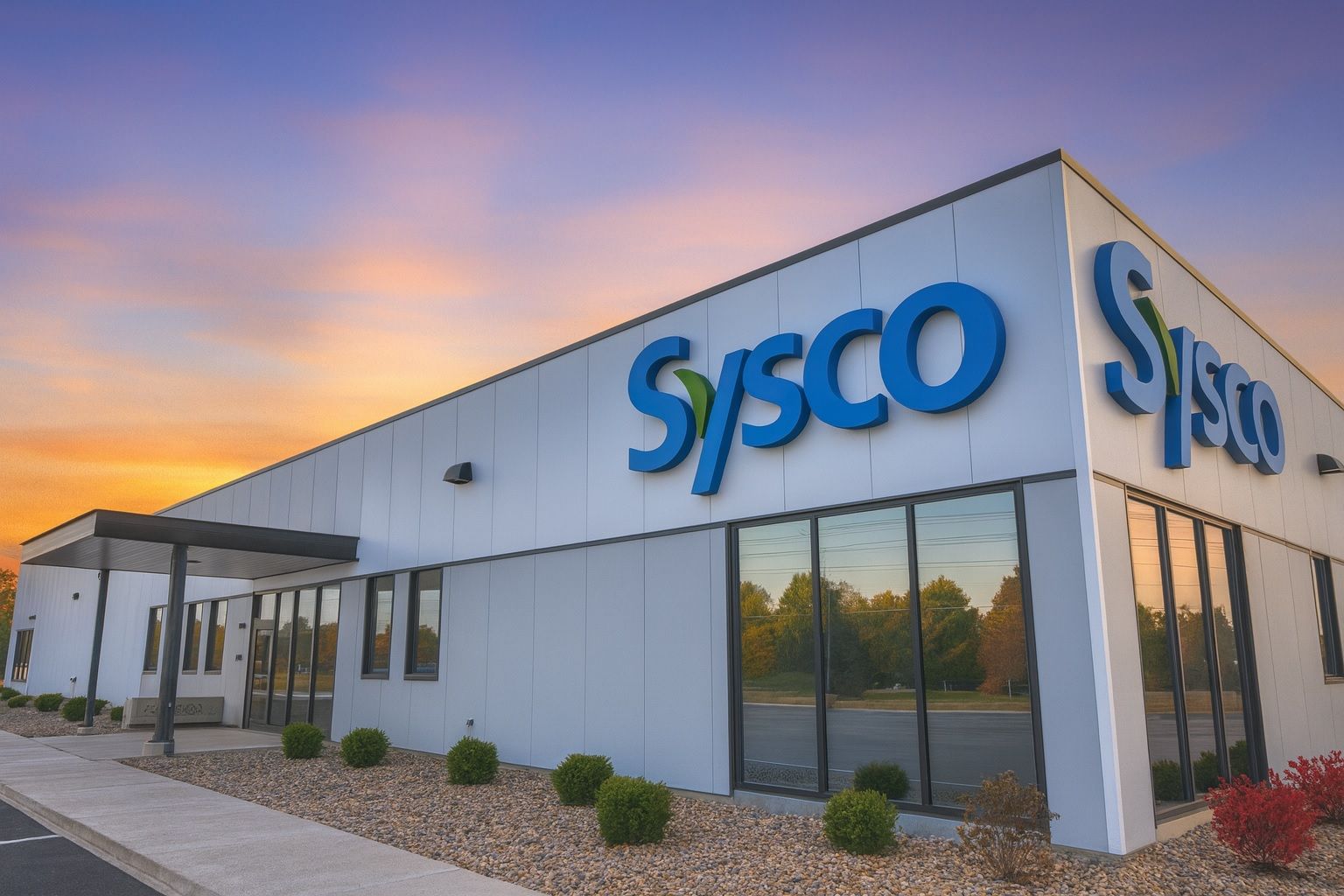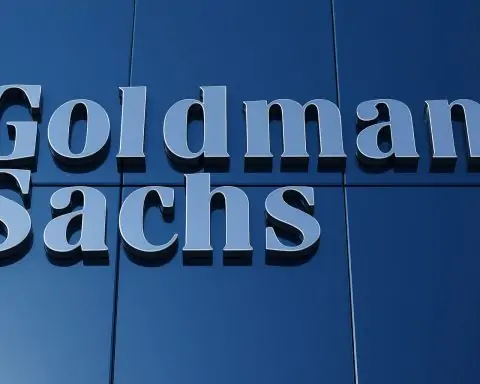- Earnings Date: Sysco Corporation will announce its first quarter fiscal 2026 results on October 28, 2025, with a conference call at 10:00 a.m. EDT that day [1]. A press release and slides will be posted beforehand, and a webcast replay will be available after the call [2] [3].
- Strong Recent Performance: Last quarter (Q4 FY2025), Sysco beat expectations – delivering adjusted earnings per share of $1.48 vs. $1.39 expected on $21.14 billion revenue (up 2.8% YoY) [4]. CEO Kevin Hourican said Q4 results “exceeded expectations” thanks to company initiatives and improved restaurant traffic [5].
- FY2026 Outlook: Management has issued cautious guidance for fiscal 2026, targeting 3–5% sales growth (~$84–85 B revenue) and 1–3% adjusted EPS growth (around $4.50–$4.60) [6]. CFO Kenny Cheung stated the team remains “cautiously optimistic” and focused on execution amid macro uncertainties [7]. Sysco plans roughly $1 billion in dividends and $1 billion in share buybacks in FY2026, signaling confidence in cash flows [8].
- Industry Leader: Sysco is the world’s largest foodservice distributor, with about 337 distribution centers across 10 countries and ~730,000 customer locations [9]. It generated over $81 billion in sales in FY2025 [10]. This scale gives Sysco an estimated 17% share of the fragmented $370 billion U.S. foodservice market [11], far ahead of most competitors (its closest rival is US Foods).
- Stock Performance: Sysco’s stock (NYSE: SYY) recently touched a 52-week high around $83 per share in early October [12]. It has since eased slightly (down about 1% from the peak [13]), trading near the $80 level. Year-to-date, SYY is up ~7%, outperforming the broader consumer staples/foodservice sector (which is down ~8%) [14]. Wall Street sentiment is broadly positive with a Moderate Buy consensus and an average price target in the mid-$80s [15].
- Analyst Expectations: Analysts project Q1 FY2026 (July–Sept 2025) revenue of about $21.0 billion and earnings of $1.12 per share [16] – a modest uptick from $20.5 B and $1.09 EPS in the prior-year quarter. Notably, consensus estimates have been trimmed slightly in recent months (EPS forecasts nudged ~3% lower) even as the stock rallied, reflecting some caution [17]. A strong beat or upbeat guidance on Oct 28 could push shares higher, while any margin disappointments or cautious tone might sour investor appetite [18].
- Key Issues to Watch: Investors will scrutinize whether sales growth is driven by volume or just price increases, and if profit margins are holding up despite cost pressures [19]. Food inflation (e.g. meat and dairy costs) and fuel/labor expenses remain a concern – input costs rose ~3.5% in Q4 [20], though Sysco managed to pass these on and even expand gross profit. Labor tensions are another looming risk: over 400 Sysco workers in California have authorized a strike if no new contract is reached by Oct. 31, with nearly 800 total West Coast employees ready to walk out in November [21]. Union representatives argue that “Sysco has absolutely no excuses” not to improve pay given the company’s strong profits [22]. How management addresses these challenges will be critical going forward.
Company Overview & Recent Performance
Sysco Corporation sits atop the foodservice distribution industry as a dominant player. The company sells and delivers food and related products to restaurants, hospitals, schools, hotels, and other venues across the globe [23]. With 337 distribution facilities serving about 730,000 customer locations worldwide, Sysco’s footprint is unmatched [24]. In the fiscal year 2025 (ended June 28, 2025), Sysco’s sales exceeded $81 billion, affirming its status as the largest “food-away-from-home” distributor on the planet [25]. This massive scale allows Sysco to leverage cost efficiencies and purchasing power; it holds roughly 17% of the U.S. foodservice distribution market, which is highly fragmented among many regional players [26]. By comparison, no other competitor comes close to Sysco’s revenue – even its nearest rival, US Foods, is substantially smaller [27].
Despite its size, Sysco has been navigating a mixed demand environment in recent quarters. The company managed to finish FY2025 on a strong note. In the fourth quarter (April–June 2025), Sysco surprised to the upside on both revenue and earnings. Sales grew about +2.8% year-over-year to $21.14 billion, and adjusted EPS came in at $1.48, beating the $1.39 consensus by nearly 7% [28]. According to CEO Kevin Hourican, Q4 results “exceeded expectations” thanks to “Sysco-specific initiatives” and an uptick in restaurant traffic driving demand [29]. In other words, the company’s strategic growth programs and operational improvements, combined with a modest rebound in customers dining out, lifted performance. Notably, Sysco achieved higher profits despite slight volume declines (total case volumes were down ~0.3% in Q4) by effectively passing through price increases and cutting costs [30] [31]. Gross profit actually rose ~3.9% in the quarter, and gross margin ticked up about 19 basis points, indicating Sysco handled inflation well [32] [33]. Food cost inflation was running ~3.5% (especially in categories like meat and dairy) [34], but Sysco’s scale and procurement strength helped it protect margins.
It’s worth noting that on a GAAP basis, some of Sysco’s Q4 earnings metrics were down due to one-time items – for instance, reported EPS was $1.10 (about –10.6% year-over-year) after a goodwill impairment charge [35]. However, excluding such charges, adjusted net income actually climbed ~3.3% and adjusted operating income grew around 1% [36] [37]. This suggests Sysco’s core business remains on a stable growth trajectory even in a somewhat mixed economic environment. Indeed, the company’s broad customer base (from independent mom-and-pop eateries to large chains and institutions) provides resilience – weakness in any one segment (say, small restaurant traffic in a region) can be offset by strength elsewhere [38]. For example, Sysco’s international segment delivered “double-digit profit growth” in Q4, helping to counter softer U.S. trends [39].
Looking back slightly further, Sysco did face headwinds earlier in 2025. In the third quarter of FY2025, sales grew only ~1.1% as the business was impacted by factors like unusually poor weather, soft restaurant demand, and inflationary pressures squeezing customers’ budgets [40]. This slower spring quarter had some analysts worried that Sysco was lagging relative to peers, and led to calls for more pricing flexibility to retain price-sensitive customers [41]. By Q4, however, the company showed it could course-correct with better execution and benefited from improving dining trends.
The October 28 Earnings Call: What to Expect
All eyes are now on Sysco’s upcoming Q1 FY2026 earnings release, scheduled for October 28, 2025. This report will cover the crucial July–September period, effectively the start of Sysco’s new fiscal year. The announcement is highly anticipated on Wall Street, as investors are eager to see whether Sysco can sustain its momentum from the strong finish last year [42]. Prior to the 10 a.m. conference call, Sysco will publish its detailed earnings press release and a slide presentation on its investor relations website to outline key financial results and business updates [43]. CEO Kevin Hourican and CFO Kenny Cheung will then host the call, fielding questions from analysts about the results and outlook [44]. Given Sysco’s stature as an industry bellwether, the discussion is likely to touch not only on the company’s numbers but also on broader foodservice trends.
Analysts’ Consensus: According to analyst forecasts, Sysco’s Q1 FY2026 is expected to show modest growth. The consensus estimates call for around $21.0 billion in revenue and $1.12 in earnings per share for the quarter [45]. That would represent a slight increase from the $20.5 billion in sales and $1.09 EPS that Sysco posted in the same quarter last year. In essence, the market is pricing in low single-digit percentage growth. Notably, these projections have been softened slightly in recent months – over the past quarter, analysts trimmed their EPS forecast for Q1 by roughly 2–3%, reflecting a bit of caution [46]. Some of this tempered expectation could be due to macro uncertainties or simply prudent modeling after a strong Q4. Yet during that same period, Sysco’s stock price climbed nearly 7% [47]. This divergence suggests that investors may be looking past short-term headwinds and remain optimistic about Sysco’s longer-term fundamentals (or expecting an upside surprise).
What to Watch: When Sysco reports on Oct 28, several key metrics and themes will be under the microscope:
- Sales Growth & Drivers: Is revenue rising organically, and if so, is it coming more from volume increases or just price inflation? Sysco has recently seen soft case volumes, so investors will want to know if transaction counts are picking up or if growth is mainly from higher pricing [48]. Healthy volume growth would indicate improving end-market demand (more meals served), whereas heavy reliance on price increases might not be sustainable long-term.
- Profitability & Margins: How are operating costs and profit margins holding up? Last quarter, Sysco protected its gross margins despite cost inflation [49] – can it maintain or improve margins in Q1? Watch for figures on operating income and net income growth. If food and fuel costs are still elevated, the degree to which Sysco can pass those costs to customers without depressing sales will be critical. Any commentary on trends in product cost inflation (which has been moderating lately) will be important [50].
- Inflation and Input Costs: Relatedly, management’s discussion of the cost environment will be key. Sysco faces volatility in food commodity prices (meat, dairy, produce, etc.), as well as rising labor and freight expenses. In Q4, product costs were up ~3.5%, but Sysco leveraged its scale to offset that [51]. Investors will look for indications of whether inflation is abating and how future cost changes might impact pricing strategy and margins.
- Volume Mix – Restaurants vs. Others: Sysco serves many sectors (independent restaurants, chains, healthcare facilities, schools, hospitality, etc.). Are certain customer segments performing better than others? For instance, restaurant traffic has been somewhat choppy industry-wide – industry foot traffic was down ~1% in mid-2025 [52] – so updates on restaurant demand early in FY2026 will be valuable. If local restaurant volumes are still soft, Sysco’s growth might be coming from other areas like institutional or international markets. The company’s broad base helped it last quarter (international operations saw double-digit profit growth) [53], so we’ll see if that diversification continues to pay off.
- Guidance and Outlook: Perhaps most importantly, any changes to forward guidance or management’s tone about the rest of FY2026 will be market-moving. Sysco has already guided for full-year growth (3–5% revenue, 1–3% EPS) [54]. Will they reiterate or adjust those targets after seeing Q1’s results? If Q1 is strong, the company could express greater confidence or even raise outlook ranges; if trends are weakening, they might strike a more cautious tone. The phrase to note is “cautiously optimistic” – CFO Cheung used this term for the FY2026 outlook [55], and investors will be listening for whether that cautious optimism persists or wavers.
- Cash Flow & Shareholder Returns: Sysco’s ability to generate cash and return capital is part of its appeal to investors. The company is a reliable dividend payer (currently about $0.54 per quarter, ~2.7% yield) and plans to return ~$2 billion to shareholders this year via dividends and buybacks [56]. Any commentary on free cash flow, dividend policy, or share repurchase activity in Q1 will interest income-focused investors. Given rising interest rates, Sysco’s debt level (debt-to-equity ~6.7×) is also a point to watch [57] – management may address how they’re managing debt and interest costs, though Fitch Ratings recently affirmed Sysco’s credit, noting its financial position remains solid for now (Altman Z-score ~5.1, indicating low bankruptcy risk) [58].
Overall, expect the Oct 28 call to be a balancing act: Sysco will likely highlight its strengths (scale advantages, cost discipline, consistent demand in core markets) but also acknowledge the headwinds (inflation, labor, macro uncertainty) that require careful navigation. As one analyst commentary predicted, the tone will probably be “cautious optimism” – confidence in Sysco’s strategy, tempered by realism about external pressures [59].
Growth Initiatives and Strategy
Sysco’s leadership knows that to stay ahead in the competitive foodservice game, the company must continue evolving. In recent years Sysco has pursued a mix of organic initiatives and acquisitions to drive growth. For example, the company has made targeted bolt-on acquisitions to expand its product offerings and geographic reach. It recently acquired Ready Chef (a meal solutions provider) and Campbells Prime Meat (a specialty meat supplier in Scotland) to broaden its portfolio and cater to shifting customer needs [60]. These deals enhance Sysco’s ability to offer more value-added products (like prepared meal components or premium meats) alongside its traditional bulk food distribution, potentially capturing new revenue streams.
On the innovation front, Sysco is also testing new concepts such as “Sysco To Go” retail formats [61]. While details are limited, this appears to be a pilot program to reach customers in new ways, perhaps smaller clients or even end consumers, indicating Sysco’s willingness to experiment beyond its classic wholesale model. Additionally, Sysco leverages its SYGMA network (which specializes in serving quick-service restaurant chains) to capitalize on growth in fast-food and fast-casual dining segments [62].
Internally, a big focus has been on efficiency and cost control. Sysco has implemented programs to streamline its operations – cutting unnecessary costs, investing in technology to optimize the supply chain, and expanding distribution capacity where needed [63]. These efforts paid off in Q4, as seen by improved gross margins despite inflation [64]. By running a tighter ship, Sysco not only protects its margins but also can be more agile in adjusting to market conditions (for example, quickly scaling logistics for seasonal demand or tightening spending when sales soften). This continuous improvement mindset will be important as economic conditions fluctuate.
Management also remains committed to shareholder value strategies like dividends and buybacks. Sysco has a long track record as a dividend stalwart – it has increased its dividend for many years and returned substantial cash to investors (over $2.3 billion in the past year via dividends and repurchases) [65]. For FY2026, the plan to return another $2 billion signals that Sysco’s growth initiatives are not coming at the expense of shareholder returns; rather, the company believes it can do both. As CFO Cheung indicated, the robust cash generation underpins these capital returns [66].
Challenges & Risks
While Sysco’s prospects appear solid, the company is not without challenges. Economic and cost pressures are a constant consideration in the food distribution business. Even though food commodity inflation has cooled somewhat from the peaks of the past couple years, certain categories remain volatile. In Q4, product costs were up ~3.5%, with particularly notable inflation in meat and dairy [67]. Sysco managed through it by using its pricing power – essentially passing most of those increases onto customers – but this strategy has limits. If inflation reaccelerates or if the economy slows down (dampening diners’ demand), Sysco could face margin compression or volume declines. Management pointed out that a resurgence of inflation or an economic downturn would indeed pose risks to volumes and profitability [68].
Another concern is Sysco’s relatively high leverage. The company carries a significant debt load (debt-to-equity around 6.7×) [69] due in part to past acquisitions and shareholder payouts. While interest rates were low, this was manageable, but in today’s higher-rate environment, debt service costs are rising. So far, Sysco’s financial health appears solid – its Altman Z-score (~5.1) indicates low bankruptcy risk [70], and ratings agencies have affirmed its credit. But if credit conditions tighten or rates continue upward, Sysco’s flexibility could be constrained. The company will need to balance growth investments with debt management (we may hear on the call about plans for debt repayment or refinancing).
Perhaps the most headline-grabbing risk at the moment is labor unrest. Sysco is facing brewing labor disputes on the U.S. West Coast. Over 400 Teamsters-represented workers at Sysco’s San Francisco distribution operation have voted unanimously to authorize a strike if a new contract isn’t reached by October 31, 2025 [71]. Similarly, around 270 workers in Portland and others in parts of California have taken strike votes [72]. In total, nearly 800 employees could potentially walk off the job in early November if negotiations falter [73]. The union is pushing for higher wages and benefits comparable to what workers have won at Sysco’s competitors. Union leaders note that “Sysco has absolutely no excuses” not to pay more given its strong profitability (Sysco earned roughly $1.95 billion net income in 2024, up 10% YoY) [74].
For Sysco, any significant labor strike could disrupt its supply chain and customer deliveries in those regions – particularly worrisome as the holiday season approaches (a peak time for foodservice). Sysco has navigated strikes before (there was a notable Teamsters strike in 2022 at some facilities), often by rerouting shipments or using temporary workers, but prolonged labor actions can impact service levels and incur higher costs. Investors will be keen to hear if management addresses this issue on the Oct 28 call – even though the strike deadline comes after the earnings release, analysts may ask how Sysco plans to mitigate the risk or if negotiations are progressing. Smooth labor relations are critical for Sysco to maintain its service reliability, which is a key selling point for its customers.
Finally, competition is an ever-present challenge. The food distribution market, while dominated by Sysco, includes regional distributors and other big players like US Foods and Performance Food Group. Some smaller rivals might cut prices to win accounts, so Sysco must balance growth with not eroding its margins through overly aggressive pricing. The company’s scale is an advantage here, but it still must continuously earn business from customers who have alternatives. Any slip in service or pricing too high could cede local market share. So far, Sysco appears to be holding its ground well – in fact, management has hinted at efforts to win market share from smaller distributors by emphasizing its efficiency and broad product range [75]. The upcoming earnings may shed light on how those competitive efforts are faring.
Market Sentiment and Stock Outlook
Sysco’s stock has been on a generally positive trajectory in 2025, reflecting improved investor sentiment about the company’s execution and resilience. As noted, SYY shares hit a new high in early October, trading up to around $83, which is near an all-time closing high [76]. Even after a slight pullback (the stock recently drifted back to ~$80), Sysco’s year-to-date performance of roughly +6–7% gain is impressive given that many consumer staples and food-related stocks have declined in the same period [77]. By comparison, a broad index of foodservice/consumer staples companies was down about 8% YTD, meaning Sysco has significantly outperformed its sector [78]. This outperformance suggests investors view Sysco as better positioned than peers to handle current challenges – likely owing to its scale and consistent profitability.
Valuation-wise, Sysco trades at roughly 17–18× forward earnings, which is a premium to the ~13–14× average for its peer group [79]. Paying a higher multiple for Sysco indicates the market’s expectation of stable growth and market leadership. The company’s robust dividend (~2.7% yield) also adds to its appeal for long-term holders [80]. Wall Street analysts remain broadly bullish on the stock: at last count, 10 analysts rate SYY a “Buy” and 4 rate it “Hold,” with no sell ratings [81]. The average price target is around $85–$86 per share [82], implying a bit of upside from current levels. Some analysts have even higher targets, north of $90, if Sysco can continue delivering earnings beats and demonstrate that it can grind out growth in a tougher economy.
What could move the stock in the near term? The Q1 earnings results and guidance on Oct 28 will be the immediate catalyst. A solid earnings “beat” – say, reporting EPS well above $1.12 or notably strong sales – combined with confident commentary, could spur a rally and perhaps push SYY to new highs. Bulls would point to Sysco’s track record (beating expectations in Q4) and shareholder-friendly moves as reasons the stock could break out. Conversely, if the earnings show any signs of weakness – for instance, if profit margins are eroding more than expected, or if management sounds uncertain about hitting full-year targets – the stock might see a pullback. As the Meyka market analysis noted, if margins disappoint or leadership strikes a wary tone, investors could react negatively and send the stock down in the short term [83]. Essentially, the market will be parsing every word on the call for confidence vs. caution.
It’s also worth noting that Sysco’s results can have a read-through effect on other foodservice industry stocks. Because Sysco is so large and touches so many restaurants and institutional food customers, its performance is something of a barometer for the broader sector [84]. If Sysco reports healthy demand and stable costs, it bodes well for restaurant suppliers and possibly restaurant companies too. If Sysco signals softness (e.g. weaker restaurant orders or pressure from rising costs), it could hint at wider industry challenges. Thus, not only Sysco’s shareholders but analysts covering related industries will be watching this earnings report closely.
Conclusion
In summary, Sysco enters its first quarter FY2026 earnings announcement with high expectations but also facing a mix of opportunities and challenges. The company’s enormous scale and recent execution (beating estimates in Q4, expanding margins) have set an optimistic tone. Management’s FY2026 guidance suggests they foresee continued growth, albeit at a moderate pace [85]. Key drivers like operational efficiencies, strategic acquisitions, and steady demand in the food-away-from-home market could help Sysco sustain its momentum. At the same time, external headwinds – from stubborn inflation in certain costs, to potential labor disruptions, to competitive pressures – mean Sysco will need to stay agile and focused.
The October 28 earnings call will be a pivotal moment to gauge whether the $81 billion foodservice giant is on track to meet those growth targets. Investors will be listening for signs that consumer demand remains resilient (are people still eating out frequently?), that Sysco can protect its margins (through pricing power and cost control), and that any one-time bumps (like the Teamsters strike threat) won’t derail its progress. The tone from CEO Hourican and CFO Cheung will be telling: if they emphasize momentum and confidence, it could reinforce the bull case; if they emphasize caution and uncertainties, the market may recalibrate expectations.
For now, analysts remain optimistic overall – Sysco is viewed as a high-quality, market-leading company that has navigated prior storms and continued to grow. The stock’s performance reflects that optimism, although it also prices in a lot of good news. Going into the earnings, Sysco’s story is one of a solid company at a crossroads between sustaining growth and fending off challenges. Come Oct 28, we’ll see if Sysco’s latest results provide a feast for investors or if any hints of weakness leave a bad taste. One thing is certain: given Sysco’s prominence, this will be an earnings report that the foodservice industry and Wall Street will closely dissect – making it, as one commentator put it, “a call worth tuning into” [86].
Sources:
- Sysco Corporation official press release via GlobeNewswire (Oct. 7, 2025) – Sysco to Announce Q1 FY2026 Results on Oct 28 [87] [88]
- Tech Space 2.0 (ts2.tech) – “Sysco Stock Soars Ahead of Q1 Earnings – Inside the $81B Food Giant’s Growth & Challenges” (Oct. 7, 2025) [89] [90]
- Meyka Market Analysis – “Sysco Schedules Oct 28 Conference Call to Discuss Q1 2026 Financials” (Oct. 8, 2025) [91] [92]
- Intellectia.ai – Analyst consensus and forecasts for Sysco’s Q1 2026 and FY2026 (data as of Oct. 2025) [93] [94]
- Teamsters Union News – Report on Sysco labor contract negotiations and strike authorization (Sept. 2025) [95] [96]
- Sysco Investor Relations – FY2025 Q4 Results and FY2026 Guidance (August 2025) [97] [98]
References
1. ts2.tech, 2. www.stocktitan.net, 3. www.stocktitan.net, 4. ts2.tech, 5. ts2.tech, 6. ts2.tech, 7. ts2.tech, 8. ts2.tech, 9. seekingalpha.com, 10. seekingalpha.com, 11. ts2.tech, 12. ts2.tech, 13. meyka.com, 14. ts2.tech, 15. ts2.tech, 16. intellectia.ai, 17. intellectia.ai, 18. meyka.com, 19. meyka.com, 20. ts2.tech, 21. ts2.tech, 22. ts2.tech, 23. seekingalpha.com, 24. seekingalpha.com, 25. seekingalpha.com, 26. ts2.tech, 27. ts2.tech, 28. ts2.tech, 29. ts2.tech, 30. ts2.tech, 31. ts2.tech, 32. ts2.tech, 33. ts2.tech, 34. ts2.tech, 35. ts2.tech, 36. ts2.tech, 37. ts2.tech, 38. ts2.tech, 39. ts2.tech, 40. meyka.com, 41. meyka.com, 42. ts2.tech, 43. ts2.tech, 44. ts2.tech, 45. intellectia.ai, 46. intellectia.ai, 47. intellectia.ai, 48. meyka.com, 49. ts2.tech, 50. ts2.tech, 51. ts2.tech, 52. ts2.tech, 53. ts2.tech, 54. ts2.tech, 55. ts2.tech, 56. ts2.tech, 57. ts2.tech, 58. ts2.tech, 59. meyka.com, 60. ts2.tech, 61. ts2.tech, 62. ts2.tech, 63. ts2.tech, 64. ts2.tech, 65. ts2.tech, 66. ts2.tech, 67. ts2.tech, 68. ts2.tech, 69. ts2.tech, 70. ts2.tech, 71. ts2.tech, 72. ts2.tech, 73. ts2.tech, 74. ts2.tech, 75. ts2.tech, 76. ts2.tech, 77. ts2.tech, 78. ts2.tech, 79. ts2.tech, 80. ts2.tech, 81. ts2.tech, 82. ts2.tech, 83. meyka.com, 84. meyka.com, 85. ts2.tech, 86. meyka.com, 87. www.stocktitan.net, 88. seekingalpha.com, 89. ts2.tech, 90. ts2.tech, 91. meyka.com, 92. meyka.com, 93. intellectia.ai, 94. intellectia.ai, 95. ts2.tech, 96. ts2.tech, 97. ts2.tech, 98. ts2.tech







